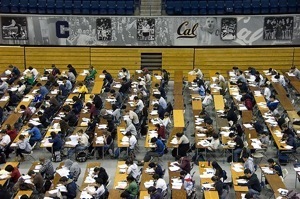Problem 4 on the Fall 2010 U.C. Berkeley Econ 1 Final...

The answer--or, at least, what I think the answer is (yes, it is cruel and unusual to ask fresh-men and -women and sophomores to do all all 8 parts in 2:30 for each part):
Let me tell you what I thought the answers to problem 4 were...
(4) Suppose that the number of espresso drinks demanded and supplied in the university city of Tall Stick are given by the equations:
Qd= 20,000 - 2000P
Qs= -10,000 + 8000P
(a) What is the market equilibrium price?
ANSWER: 30,000 = 10000P. P = $3/drink.
(b) What is the market equilibrium quantity?
ANSWER: 20000 - 2000(3) = Q. 14000 drinks
(c) What is the producer surplus?
ANSWER: The lowest-cost producer has a cost of $1.25. The highest-cost producer has a cost of $3. The average cost for producers is thus $2.12 1/2. A price of $3 gives average producer surplus of $0.87 1/2 per drink. Multiply by 14000 drinks and get $12,250
(d) What is the consumer surplus?
ANSWER: The highest-value consumer has a value of $10. The lowest-value consumer has a value of $3. The average value for consumers is thus $6.50. There are thus $3.50 of consumer surplus per drink. Multiply by 14000 drinks and get $49000.
(e) Suppose that the university students of Crony Capitalism University in Tall Stick, hyped up on caffeine, begin trashing the town and the city of Tall Stick imposes a $1 per drink graffiti clean-up tax on espresso drinks. What is the new market equilibrium price?
ANSWER: We now have 20000 - 2000(P+1) = -10000 + 8000P. 10000P = 28000. P = $2.80. (P to consumers is now $3.80)
(d) Suppose that the university students of Crony Capitalism University in Tall Stick, hyped up on caffeine, begin trashing the town and the city of Tall Stick imposes a $1 per drink graffiti clean-up tax on espresso drinks. What is the new market equilibrium quantity?
ANSWER: -10000 + 8000(2.80) = 12,400 drinks
(g) Suppose that the university students of Crony Capitalism University in Tall Stick, hyped up on caffeine, begin trashing the town and the city of Tall Stick imposes a $1 per drink graffiti clean-up tax on espresso drinks. What is the new total surplus assuming that $1 of government revenue has the same social value as $1 of consumer or producer surplus?
ANSWER: An extra-credit answer points out that we do not know whether the $1/drink tax is the right Pigouvian tax or not, and then goes on to solve the problem making some assumption about what graffiti-damage-per-drink is. An answer that gets full credit assumes that $1 per drink is the right Pigouvian tax, in which case we have:
Producer surplus: 12400 x (2.80 - 1/2 x (2.80 + 1.25)) = 9610
Consumer surplus: 12400 x (1/2 x (3.80 + 10) - 3.80)) = 38440
Graffiti damage: -12400
Value of cleanup: 12400
Total: 48010
(h) In (g), what must be the value of each $1 spent by the city of Tall Stick on graffiti cleanup for the decision to impose the $1 per drink tax and then spend all the revenue on graffiti cleanup to raise social welfare?
ANSWER: Once again, an extra-credit answer points out that we do not know whether the $1/drink tax is the right Pigouvian tax or not, and then goes on to solve the problem making some assumption about what graffiti-damage-per-drink is. An answer that gets full credit assumes that $1 per drink is the right Pigouvian tax, in which case we have:
Surplus with tax: 48010 + (b-1)(government revenue), where b is the value of $1 spent on graffiti cleanup
Surplus without tax: 49000+12250-14000 = 47250
48010 + (b-1)(revenue) = 47250
760 = (1-b)12400
1-b = 760/12400
1-b = .06129
b = 0.9387
So as long as $1 of cleanup does at least $0.9387 worth of graffiti removal, the tax is a good idea (although not necessarily the best idea).



J. Bradford DeLong's Blog
- J. Bradford DeLong's profile
- 90 followers



